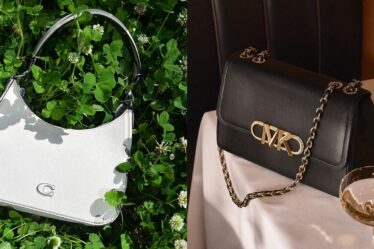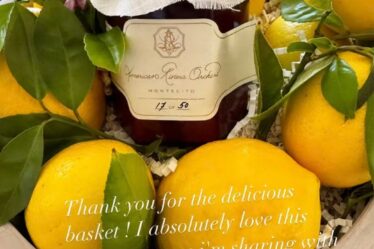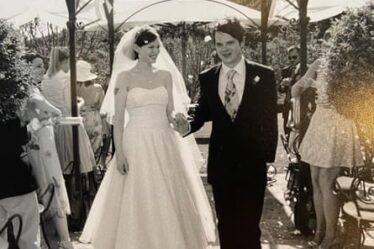
LONDON — If last season Simone Rocha lifted us up to the heavens, this time around she described her collection as “grounding” and “earthy.” But there was nothing down to Earth about the grandeur of Central Westminster Hall, complete with a giant organ, and the impressive collection that Rocha sent out. Going back to her Irish roots, the designer found inspiration in the harvest festival of Lughnasadh, hence why puffed-out dresses were stuffed with real hay and macramé straw formed sublime showpieces. Her Irish sensibility can be a dark one, which gave the procession of Rocha-fied women (and men) in lace, bows, velvet and sailor accents (Ireland is an island after all) an eeriness that was amplified by a live performance by Irish contemporary folk band Lankum. The effect was pure exaltation. Could her vision find a home at a maison beyond her own brand? Something to ponder.
At Richard Quinn, the large-scale set — Frances Hodgson Burnett’s secret garden, complete with orchestra and flowers galore — created a heightened sense of anticipation. But the clothes were always going to be floral-print numbers, punctuated with black latex. Business as usual for Quinn, then. His clients are perhaps satisfied with his winning formula.
Knowing your market is something David Koma does well, too. Up in a glass City tower, the designer hammered home his sexy, slitted attire exclusively in red and black, against an on-the-nose red carpet. No prizes for guessing where most of these looks will end up. Ditto for 16Arlington whose designer Marco Capaldo seems to have honed in on a dress-up-up aesthetic with moody undertones, as if still in mourning for co-founder Kikka Cavenati.
Designers can be sheepish about showing “just clothes.” Molly Goddard isn’t one of them. “These clothes should be worn and worn again,” she said backstage at her studio space in Bethnal Green, where she staged her show. And so we got up and personal with proper clothes — a new gen #FrazzledEnglishWoman uniform if you will — consisting of cardigans, casual tulle and ribbon-trimmed wool coats and jackets. The no-fuss, slimmed down approach made for a convincingly wearable proposal.
Roksanda Ilinčić also went for intimacy, albeit in the opulent setting of Claridges. But there was a touching tenderness to her bubble gowns, fluid suiting and two-tone satin sheath dresses in her idiosyncratic colour ways, inspired by avant-garde Japanese artist Atsuko Tanaka. The finale passage of chiffon gowns structured with tubes evoked Tanaka’s wearable “Electric” dresses as Ilinčić played to her galerina-intelligentsia clients.
Priya Ahluwalia was in her happy place, boosted by memories of her teenage playlist, from Lauren Hill’s “Doo Wop” to Tupac’s “Do for Love.” Her musical journey was reflected in oftentimes literal homages as seen in a fishtail denim ensemble, but Ahluwalia also came up with an unexpected print, utilising sound wave patterns as well as working in the detailing of an Indian drum. And like many of her contemporaries, upcycling was a thing.
Some tapped into darker territory for inspiration. “Society is on the brink of collapse,” said London returnee Mowalola Ogunlesi, citing the dark web as inspiration. Ogunlesi is ready to outfit everyone from the “corporate people to the people in the streets,” as she riffed off the Yankees, the NBA and MOMA logos and sent down meme-able dropped crotch jeans and skirts with belts at the knees. Then things got feral with sharply cut shorts and backless minis in pony and leather. The dystopianism was heavy but the clothes were arresting.
Chet Lo also looked to youthful angst as he plunged his signature spiky knits in black and bravely explored new fabrication techniques like segueing wool into silk and manipulating leather. Some of the experiments didn’t quite come off, but his energy is infectious.
When Erdem Moralıoğlu peeled back the layers of his Bloomsbury home, he uncovered its past as a 19th century “House of Hope,” a place of refuge for “fallen women.” The female ghosts in the walls re-emerged under dim lights at Sadler’s Wells in Victorian garb of murky green, purple and yellow. Leg of mutton sleeves and jet embroidery were chopped and displaced. Moralıoğlu’s tulle-trapped silks and spectacularly embroidered slips under black organza reflected the brittle mood in London, although the effect was uplifting.
Jonathan Anderson’s namesake brand has grown significantly in the last 15 years on the back of inventive design, savvy branding and accessible price points. That’s perhaps why he felt comfortable revisiting his archives and colliding them with a personal hero: dance iconoclast Michael Clark. The graphic visuals of Clark’s performances dominated the set and popped up in the collection: think a phallus or two, and glittery fingers stuck up at you. “Britain has this angst that ultimately goes against things,” said Anderson. But as he namechecked a rebellious canon including Clark, Leigh Bowery and, of course, Vivienne Westwood, he had cannily updated his silhouettes to chime with today’s market. No bad combo.



